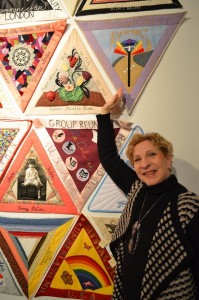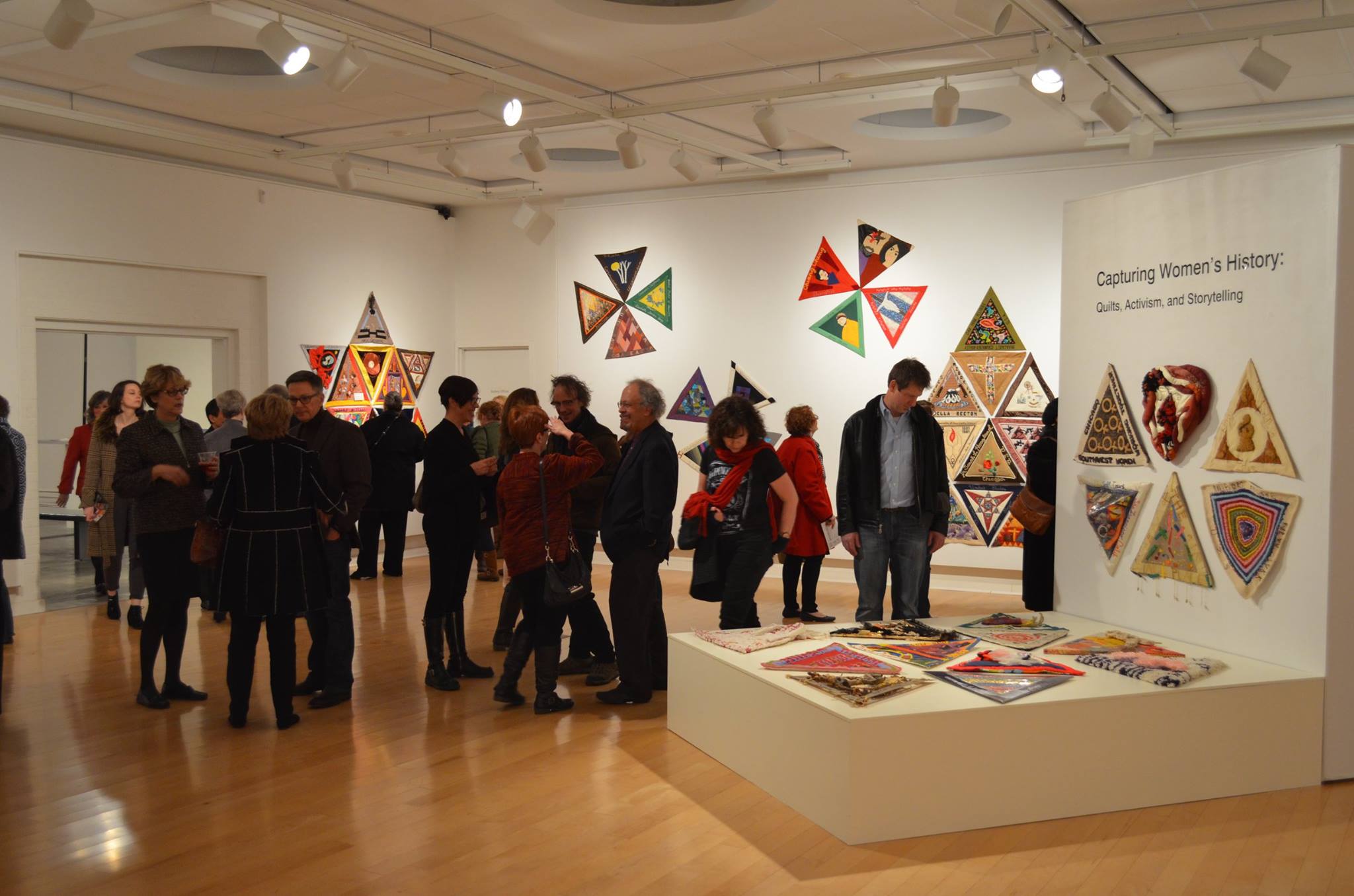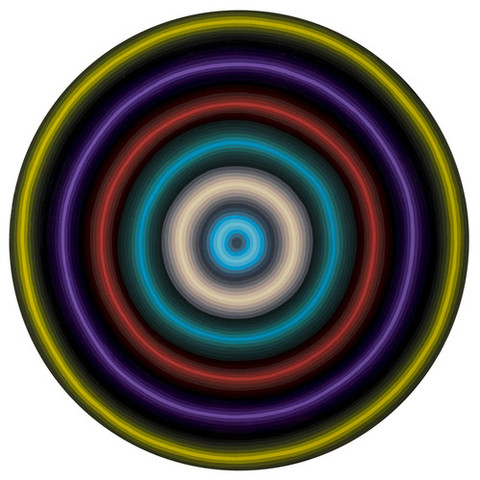Photo courtesy Renee Murphy/Hite Institute.
Capturing Women’s History: Quilts, Activism, and Storytelling
Hite Art Institute
Review by Kay Polson Grubola
Entire contents copyright © 2016 Kay Polson Grubola. All rights reserved.
I have a small, rectangular, bar pin I like to wear. It is inscribed: Anonymous was a Woman. I tried to put it on for a reception for Capturing Women’s History: Quilts, Activism, and Storytelling at the Hite Art Institute but the pin’s point had become so dulled from use it wouldn’t go through my jacket. It made me think about the journey that this show represents and how Judy Chicago’s view that women couldn’t advance as long as they were deprived of their history has proven true.
People, especially young women, tend to reject the term feminism today, finding it somehow unacceptably aggressive. How strange, because as I walked through the show looking at art made 36 years ago it was just as powerful and relevant as it was in the 1980’s. If feminism was so aggressive why are we still struggling with the same issues today?
Feminist artist, Judy Chicago, set new precedents in the late seventies when initiating her monumental work The Dinner Party. She conceived a work of art that would reclaim women’s history using the skills that were traditionally considered “women’s work”. Activating a collaborative team of women using techniques and mediums that would celebrate women’s work she legitimized women’s artistry. In doing so she changed both the feminism dialogue and art driven social activism.
The Dinner Party celebrated 1,038 women in history. 39 women are honored by place settings on a three-sided table that measures 48 ft. on each side. Another 999 names were inscribed in the Heritage Floor on which the table rests.
The inevitable questions arose about who was included and excluded when The Dinner Party was exhibited. What happened next was not so easy to predict. Ms. Chicago invited women to participate in shaping the conversation by using another traditional medium…quilting. Twenty-four inch triangular quilt pieces honoring women; mothers, teachers, mentors and women’s groups poured in from all over the world. At each exhibition site more pieces arrived, forming a richly textured, interlocking backdrop for The Dinner Party. Each contributing artist was asked to include a short biography of the maker, the honoree, and the techniques used. An extraordinary facet of the collection is the universality of the contributions. Many artists responded with beautifully crafted pieces but many others, people who had never thought of themselves as visual artists, felt compelled to participate in this validation of the women in their lives.
Five hundred thirty-nine quilt pieces survive today and have, through an extraordinary gift from Judy Chicago and her foundation, Through the Flower, been entrusted to the University of Louisville, Hite Art Institute. The International Honor Quilt will be the inspiration for an ongoing conversation about art as a catalyst for change. The University of Louisville’s bid to obtain this work of art was made possible in large part through the efforts of Shelly Zegart, who initiated and shepherded the acquisition of the quilt.
Capturing Women’s History: Quilts, Activism, and Storytelling, is the public debut of this wonderful gift. Celebrated women include role models such as, Mother Teresa, Emily Dickinson, Abigail Adams and Eleanor Roosevelt, but the majority of the quilt triangles honor unheralded women. Along with family members and mentors are organizations like the League of Women Voters and the American Association of University Women.
The addition of the International Honor Quilt to the The Dinner Party, although it was not a part of the initial concept, changed public art and social justice works of art in significant ways. A group, inspired by the Honor Quilt, approached Ms. Chicago, eager to start a project that would increase awareness of the AID’s epidemic. She consulted with them and the resulting project was the AID’s Memorial Quilt, composed of over 48,000 panels, which was eventually shown on the Mall in Washington, D.C. Today projects of this kind are still flourishing. Currently, the Monument Quilt, a traveling exhibit in support of survivors of sexual assault, is traveling to colleges around the country.
For this exhibition curator Margaret Leininger re-contextualized the installation of the works in the main gallery. Referencing traditional quilt patterns, she has constructed a metaphor for quilt making and a link for the viewer to Ms. Chicago’s original concept of the authentication of women’s work as art. Ms. Leininger’s bold step was the right thing to do; by creating an installation with much more breathing space the viewer can more easily see each individual quilt piece. The complexity of many of the pieces can be more fully enjoyed in this new mounting of the show.
In the second room of the exhibition, visitors can experience a section with the original installation design: hanging in interlocking rows creates a very dense effect. It emphasizes the mass of pieces creating the quilt and the rhythm they generate. Offering both designs is an interesting way of expanding and enriching the experience.

Ruth Rothbart-Mayer, pointing out her quilt, which honors her grandmother. Photo courtesy Renee Murphy/Hite Institute
A highlight of the February 12 opening was a short presentation by internationally respected performance artist, Suzanne Lacey, who works with social themes and urban issues. The presence of one of the original makers, Ruth Rothbart-Mayer, was also a special and welcomed surprise. She memorialized her grandmother’s influence in her life in her quilt piece all those years ago and traveled from New Jersey to be a part of the celebration. The appeal of the visual images of Capturing Women’s History: Quilts, Activism, and Storytelling, is undeniable, but the accompanying stories of the women’s lives they represent are poignant. Stitching together the stories of these diverse women was an empowering act in the 1980’s. Today it offers a unique opportunity to connect with issues that remain in the forefront of social justice concerns and measure our progress.
The third Hite Gallery space offers another collaborative fabric piece titled Hot Flash Fan (1985). The lead artists of the work were respected Louisville artist Ann Stewart Anderson and Judy Chicago, but more than 50 Kentucky artists participated in the design and crafting of the piece. Hot Flash Fan includes needlework, quilting, and painting in its depiction of the experience of menopause. The Kentucky Foundation for Women bought the piece and it has been housed in their offices until recently. It was while working on this piece that Chicago first visited Louisville and became acquainted with Zegart.
Capturing Women’s History: Quilts, Activism, and Storytelling
February 1 – March 19, 2016
Schneider Hall Galleries, Belknap Campus,
Hite Art Institute at the University of Louisville
Louisville, KY 40299
To see all of the quilt images on line go to: http://digital.library.louisville.edu/cdm/search/collection/ihq/page/1
Kay Polson Grubola is an artist and independent curator in Louisville, Kentucky. She has shown her work nationally and internationally. Grubola was the Executive Director of Nazareth Arts, a regional arts center on the campus of the Sisters of Charity of Nazareth in Kentucky, as well as the Artistic Director of the Louisville Visual Art Association. For 10 years she taught drawing and printmaking at Bellarmine University and Indiana University Southeast. As a curator, her exhibits have ranged in subject matter from original concept drawings from the design studios of GM, Chrysler and Ford muscle car era to a nationally recognized extravaganza of handmade dinnerware and exquisite table design, which wowed audiences for more than 20 years.






